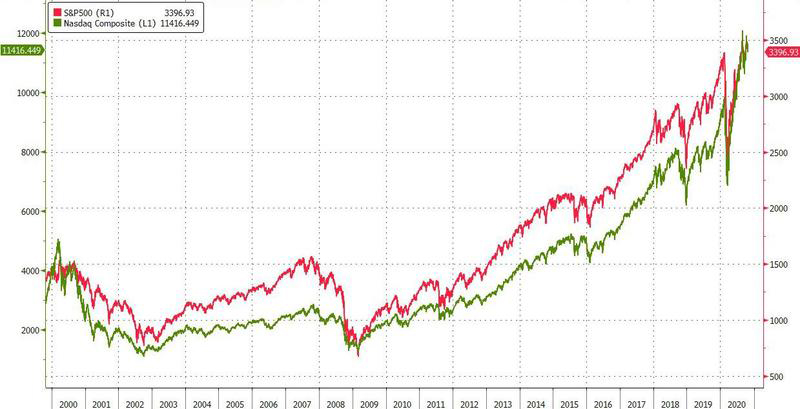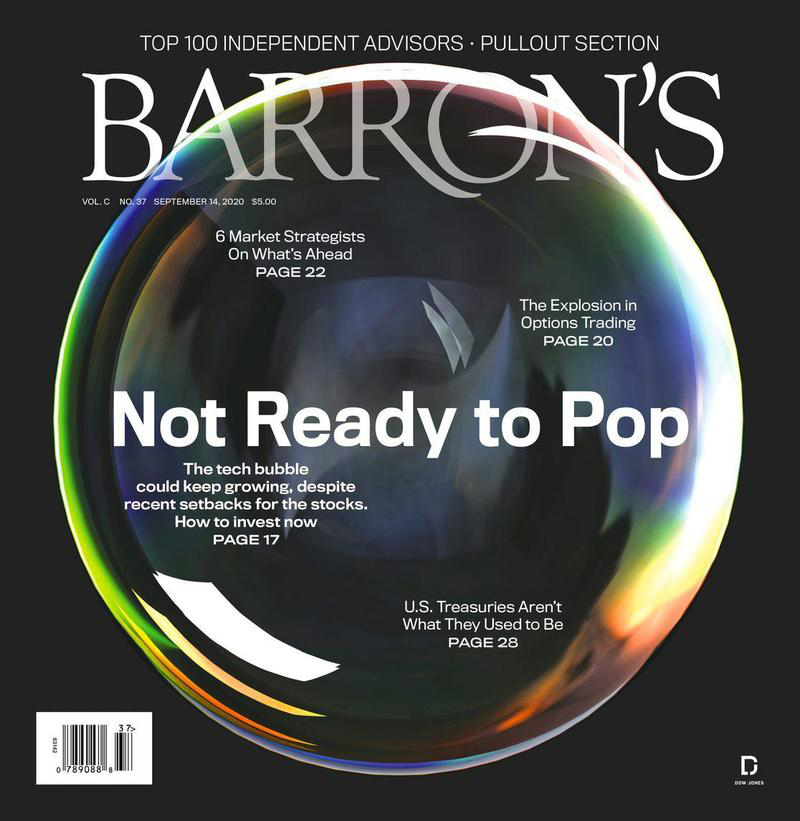David Einhorn: "This Is An Enormous Tech Bubble"
And It Popped On September 2, 2020
Tyler Durden
 For those who have not followed David Einhorn's crusade against central bank money printing, and the epic bubble these cluless academic hacks have created, his views on the "enormous tech bubble" we are currently living through and published in his latest letter to investors of his Greenlight hedge fund (which returned 5.9% in Q3) will provide some unique perspective. For those who have not followed David Einhorn's crusade against central bank money printing, and the epic bubble these cluless academic hacks have created, his views on the "enormous tech bubble" we are currently living through and published in his latest letter to investors of his Greenlight hedge fund (which returned 5.9% in Q3) will provide some unique perspective.
To everyone else who is familiar with how his fund has been hammered by his tech short basket - and especially Tesla - over the years as the most overvalued tech stocks in history continued to rip higher year after year, we doubt his latest thoughts will come as a surprise, although his observations on the endgame are certainly remarkable, if for no other reason that he now declared the time of death of said "enormous tech bubble" as Sept 2, 2020, the day the S&P500 and the Nasdaq both hit an all time high.

Why is Einhorn confident that this time he has finally timed the exact moment the bubble popped? He explains:
Bubbles tend to topple under their own weight. Everybody is in. The last short has covered. The last buyer has bought (or bought massive amounts of weekly calls). The decline starts and the psychology shifts from greed to complacency to worry to panic. Our working hypothesis, which might be disproven, is that September 2, 2020 was the top and the bubble has already popped. If so, investor sentiment is in the process of shifting from greed to complacency. We have adjusted our short book accordingly including adding a fresh bubble basket of mostly second-tier companies and recent IPOs trading at remarkable valuations
So without further ado, below we excerpt his key thoughts on the biggest asset bubble that the Fed has inflated:
* * *
We are now in the midst of an enormous tech bubble. We prematurely identified what we thought was a bubble in early 2016. Part of our thinking at the time was that the height of the 1999-2000 bubble was a once-in-a-career experience and that investors would not repeat that level of insanity. Clearly, we were mistaken.
Four years later, there is a consensus that we are in a bubble. Barron’s recently ran this on the cover:

All the signs of a bubble are there, including:
- an IPO mania;
- extraordinary valuations and new metrics for valuation;5
- a huge market concentration in a single sector and a few stocks;
- a second tier of stocks that most people haven’t heard of at S&P 500-type marketcapitalizations;
- the more fanciful and distant the narrative, it seems the better the stock performs;
- outperformance of companies suspected of fraud based on the consensus belief thatthere is no enforcement risk, without which crime pays;
- outsized reaction to economically irrelevant stock splits;
- increased participation of retail investors, who appear focused on the best-performing names;
- incredible trading volumes in speculative instruments like weekly call options andworthless common stock;6 and
- a parabolic ascent toward a top.
There are many anecdotes of toppy behavior. We will share one: We recently received a job application with the email subject, “I am young, but good at investments” from a 13-year-old who purports to have quadrupled his money since February.
Some analysts and commentators are comparing this bubble to the prior one. Have the valuations reached the prior insanity’s? Is the IPO mania just as large? Are the companies better today? Are they growing faster? Have the specific events that popped the last bubble happened? Are they likely to happen soon?
We believe these questions are a fool’s errand. The bubbles will never be exactly the same. In 2000, the Nasdaq peaked at 5,000. Why not 4,000? Why not 10,000? Or 20,000? Would there really have been a difference? If the Nasdaq had peaked at 3,500 instead of 5,000, the losses would have been 65% instead of 80%. Had it peaked at 3,500, it would be easier to argue that this bubble has surpassed that one. Had it peaked at 20,000, it would be easier to argue that there is still a long way to go. This analysis is arbitrary. Is a bubble only dangerous when it has exceeded the prior one on every metric?
What matters in a bubble is market psychology, not valuation. Valuation is irrelevant; that’s what makes it a bubble. Jeremy Grantham has done some of the best work on bubbles and by his criteria this one is a “Real McCoy.” The question at hand is where are we in the psychology of this bubble? On March 10, 2000, nobody knew that it was the top. Even by September 2000, it wasn’t clear. There was no obvious event that marked the top. Only in hindsight do people try to back fit an explanation.
Bubbles tend to topple under their own weight. Everybody is in. The last short has covered. The last buyer has bought (or bought massive amounts of weekly calls). The decline starts and the psychology shifts from greed to complacency to worry to panic. Our working hypothesis, which might be disproven, is that September 2, 2020 was the top and the bubble has already popped. If so, investor sentiment is in the process of shifting from greed to complacency. We have adjusted our short book accordingly including adding a fresh bubble basket of mostly second-tier companies and recent IPOs trading at remarkable valuations.
 our mission: our mission:
to widen the scope of financial, economic and political information available to the professional investing public.
to skeptically examine and, where necessary, attack the flaccid institution that financial journalism has become.
to liberate oppressed knowledge.
to provide analysis uninhibited by political constraint.
to facilitate information's unending quest for freedom.
our method: pseudonymous speech...
Anonymity is a shield from the tyranny of the majority. it thus exemplifies the purpose behind the bill of rights, and of the first amendment in particular: to protect unpopular individuals from retaliation-- and their ideas from suppression-- at the hand of an intolerant society.
...responsibly used.
The right to remain anonymous may be abused when it shields fraudulent conduct. but political speech by its nature will sometimes have unpalatable consequences, and, in general, our society accords greater weight to the value of free speech than to the dangers of its misuse.
Though often maligned (typically by those frustrated by an inability to engage in ad hominem attacks) anonymous speech has a long and storied history in the united states. used by the likes of mark twain (aka samuel langhorne clemens) to criticize common ignorance, and perhaps most famously by alexander hamilton, james madison and john jay (aka publius) to write the federalist papers, we think ourselves in good company in using one or another nom de plume. particularly in light of an emerging trend against vocalizing public dissent in the united states, we believe in the critical importance of anonymity and its role in dissident speech. like the economist magazine, we also believe that keeping authorship anonymous moves the focus of discussion to the content of speech and away from the speaker- as it should be. we believe not only that you should be comfortable with anonymous speech in such an environment, but that you should be suspicious of any speech that isn't.
www.zerohedge.com | 



